Community Engagement Strategy for Lung Cancer Prevention and Smoking
VerifiedAdded on 2022/08/25
|12
|2833
|9
Essay
AI Summary
This essay provides a comprehensive analysis of community engagement strategies for lung cancer prevention, focusing on the Australian context. It begins by highlighting the significant impact of smoking on lung cancer incidence and mortality, emphasizing the need for community-based interventions. The essay explores key strategies for engaging communities, drawing upon the Laverack's model of participation, and discusses the roles of government and local authorities in implementing these strategies. It then delves into capacity building for community empowerment, examining various domains such as skill development, resource mobilization, and leadership, all crucial for effective health promotion programs. Furthermore, the essay examines health promotion models like the Health Belief Model and educational approaches, evaluating their advantages and disadvantages in the context of smoking cessation and lung cancer prevention. The essay concludes by reiterating the importance of community involvement and empowerment in mitigating the burden of lung cancer and promoting overall public health.
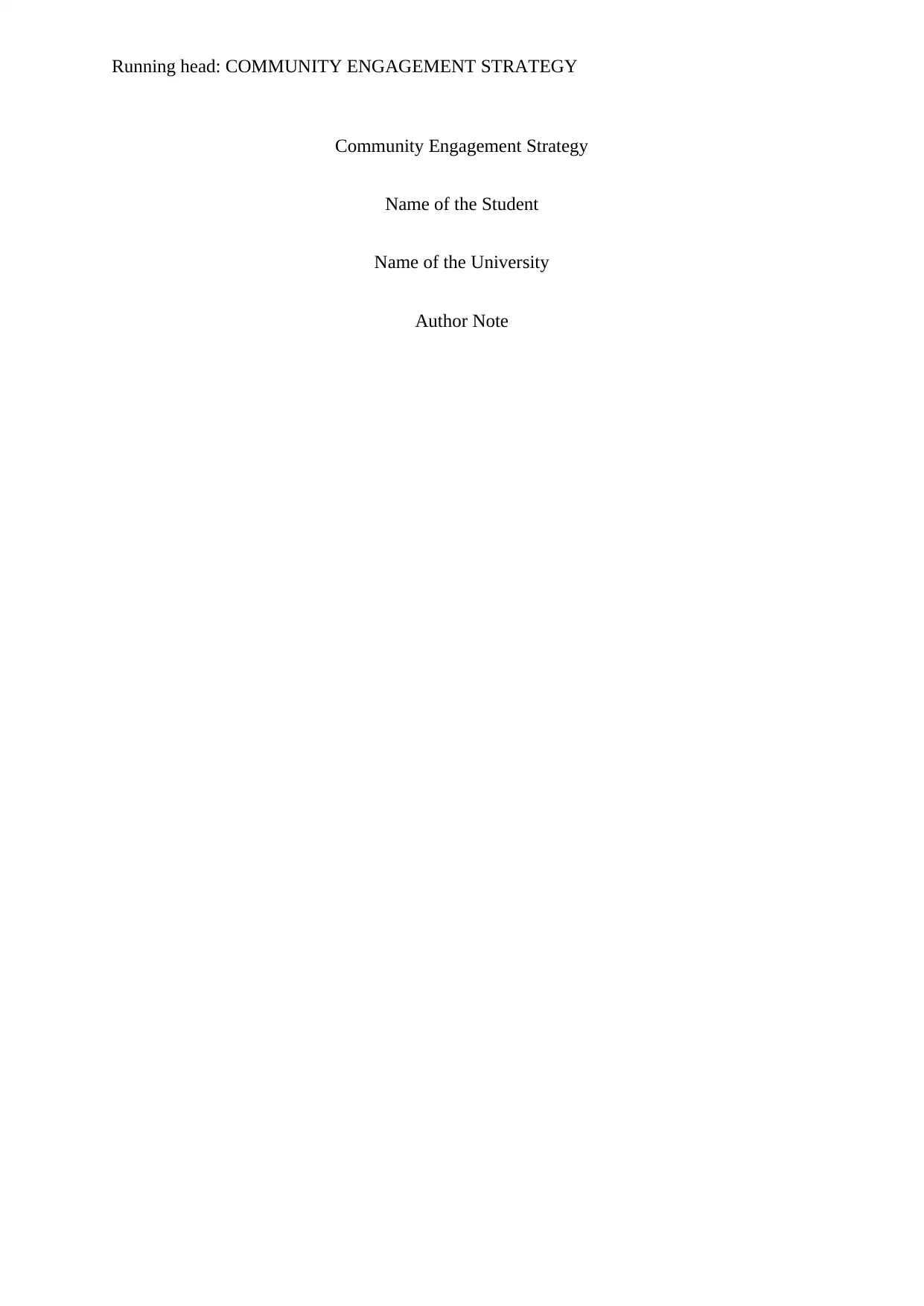
Running head: COMMUNITY ENGAGEMENT STRATEGY
Community Engagement Strategy
Name of the Student
Name of the University
Author Note
Community Engagement Strategy
Name of the Student
Name of the University
Author Note
Paraphrase This Document
Need a fresh take? Get an instant paraphrase of this document with our AI Paraphraser
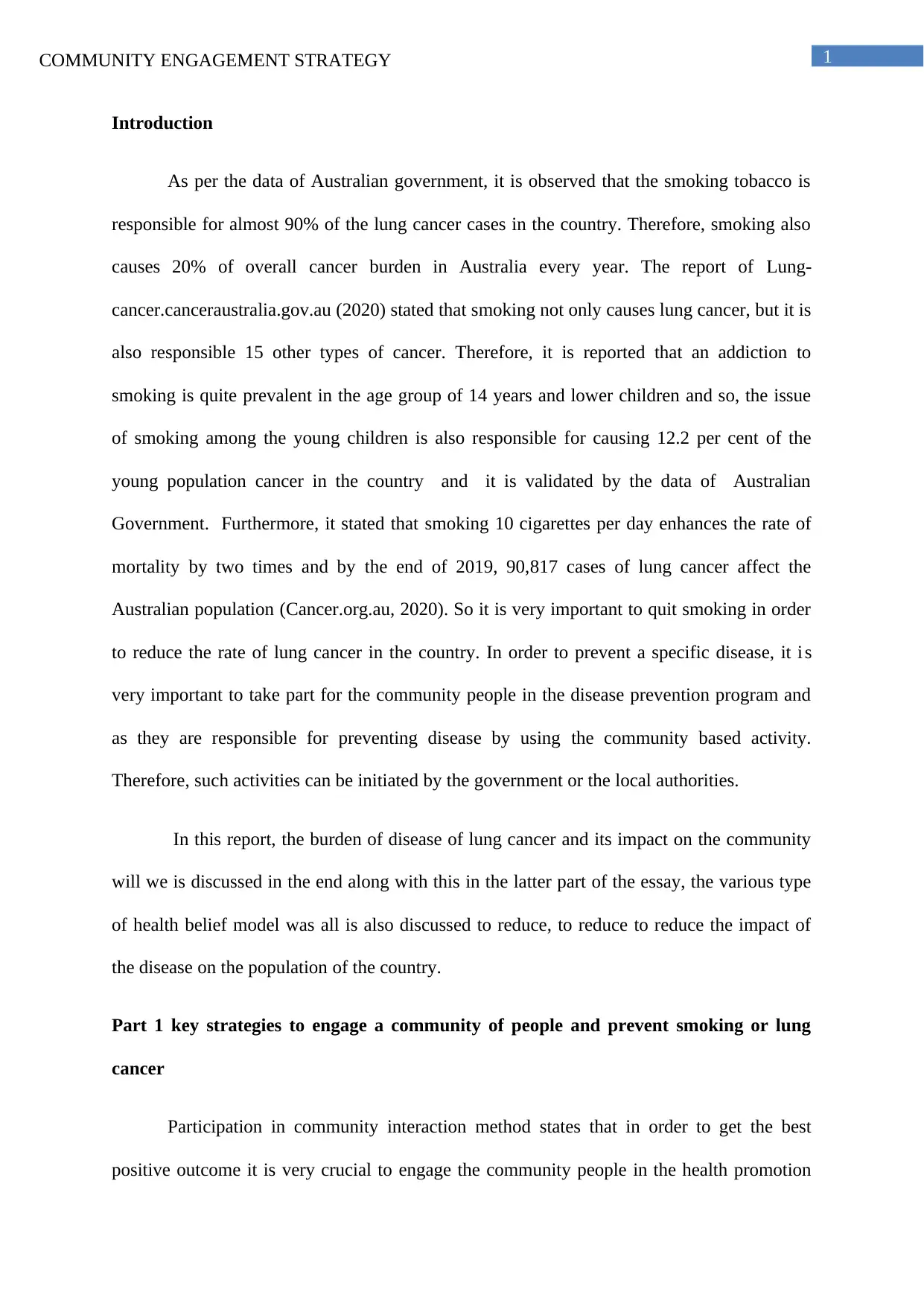
1COMMUNITY ENGAGEMENT STRATEGY
Introduction
As per the data of Australian government, it is observed that the smoking tobacco is
responsible for almost 90% of the lung cancer cases in the country. Therefore, smoking also
causes 20% of overall cancer burden in Australia every year. The report of Lung-
cancer.canceraustralia.gov.au (2020) stated that smoking not only causes lung cancer, but it is
also responsible 15 other types of cancer. Therefore, it is reported that an addiction to
smoking is quite prevalent in the age group of 14 years and lower children and so, the issue
of smoking among the young children is also responsible for causing 12.2 per cent of the
young population cancer in the country and it is validated by the data of Australian
Government. Furthermore, it stated that smoking 10 cigarettes per day enhances the rate of
mortality by two times and by the end of 2019, 90,817 cases of lung cancer affect the
Australian population (Cancer.org.au, 2020). So it is very important to quit smoking in order
to reduce the rate of lung cancer in the country. In order to prevent a specific disease, it i s
very important to take part for the community people in the disease prevention program and
as they are responsible for preventing disease by using the community based activity.
Therefore, such activities can be initiated by the government or the local authorities.
In this report, the burden of disease of lung cancer and its impact on the community
will we is discussed in the end along with this in the latter part of the essay, the various type
of health belief model was all is also discussed to reduce, to reduce to reduce the impact of
the disease on the population of the country.
Part 1 key strategies to engage a community of people and prevent smoking or lung
cancer
Participation in community interaction method states that in order to get the best
positive outcome it is very crucial to engage the community people in the health promotion
Introduction
As per the data of Australian government, it is observed that the smoking tobacco is
responsible for almost 90% of the lung cancer cases in the country. Therefore, smoking also
causes 20% of overall cancer burden in Australia every year. The report of Lung-
cancer.canceraustralia.gov.au (2020) stated that smoking not only causes lung cancer, but it is
also responsible 15 other types of cancer. Therefore, it is reported that an addiction to
smoking is quite prevalent in the age group of 14 years and lower children and so, the issue
of smoking among the young children is also responsible for causing 12.2 per cent of the
young population cancer in the country and it is validated by the data of Australian
Government. Furthermore, it stated that smoking 10 cigarettes per day enhances the rate of
mortality by two times and by the end of 2019, 90,817 cases of lung cancer affect the
Australian population (Cancer.org.au, 2020). So it is very important to quit smoking in order
to reduce the rate of lung cancer in the country. In order to prevent a specific disease, it i s
very important to take part for the community people in the disease prevention program and
as they are responsible for preventing disease by using the community based activity.
Therefore, such activities can be initiated by the government or the local authorities.
In this report, the burden of disease of lung cancer and its impact on the community
will we is discussed in the end along with this in the latter part of the essay, the various type
of health belief model was all is also discussed to reduce, to reduce to reduce the impact of
the disease on the population of the country.
Part 1 key strategies to engage a community of people and prevent smoking or lung
cancer
Participation in community interaction method states that in order to get the best
positive outcome it is very crucial to engage the community people in the health promotion
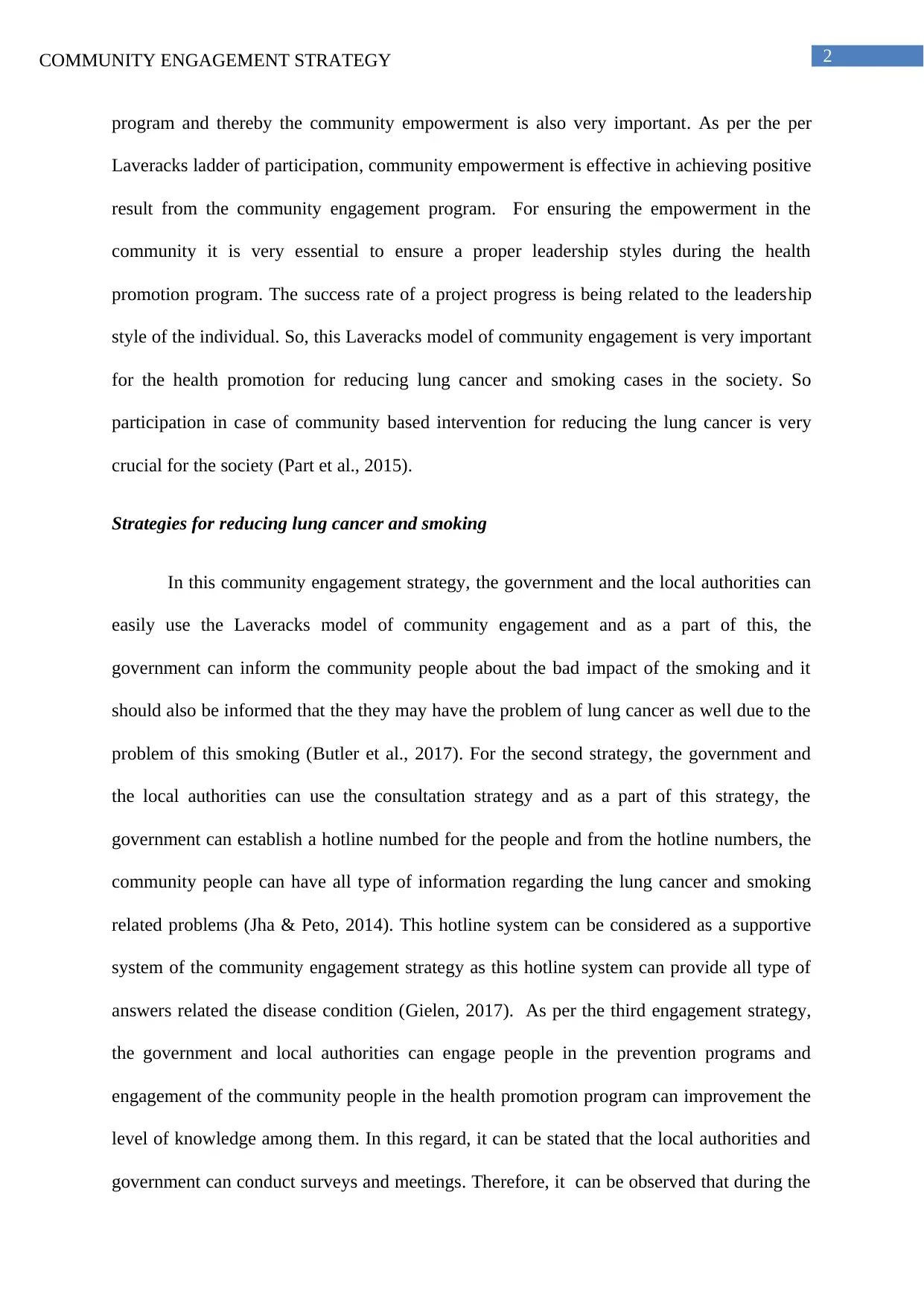
2COMMUNITY ENGAGEMENT STRATEGY
program and thereby the community empowerment is also very important. As per the per
Laveracks ladder of participation, community empowerment is effective in achieving positive
result from the community engagement program. For ensuring the empowerment in the
community it is very essential to ensure a proper leadership styles during the health
promotion program. The success rate of a project progress is being related to the leadership
style of the individual. So, this Laveracks model of community engagement is very important
for the health promotion for reducing lung cancer and smoking cases in the society. So
participation in case of community based intervention for reducing the lung cancer is very
crucial for the society (Part et al., 2015).
Strategies for reducing lung cancer and smoking
In this community engagement strategy, the government and the local authorities can
easily use the Laveracks model of community engagement and as a part of this, the
government can inform the community people about the bad impact of the smoking and it
should also be informed that the they may have the problem of lung cancer as well due to the
problem of this smoking (Butler et al., 2017). For the second strategy, the government and
the local authorities can use the consultation strategy and as a part of this strategy, the
government can establish a hotline numbed for the people and from the hotline numbers, the
community people can have all type of information regarding the lung cancer and smoking
related problems (Jha & Peto, 2014). This hotline system can be considered as a supportive
system of the community engagement strategy as this hotline system can provide all type of
answers related the disease condition (Gielen, 2017). As per the third engagement strategy,
the government and local authorities can engage people in the prevention programs and
engagement of the community people in the health promotion program can improvement the
level of knowledge among them. In this regard, it can be stated that the local authorities and
government can conduct surveys and meetings. Therefore, it can be observed that during the
program and thereby the community empowerment is also very important. As per the per
Laveracks ladder of participation, community empowerment is effective in achieving positive
result from the community engagement program. For ensuring the empowerment in the
community it is very essential to ensure a proper leadership styles during the health
promotion program. The success rate of a project progress is being related to the leadership
style of the individual. So, this Laveracks model of community engagement is very important
for the health promotion for reducing lung cancer and smoking cases in the society. So
participation in case of community based intervention for reducing the lung cancer is very
crucial for the society (Part et al., 2015).
Strategies for reducing lung cancer and smoking
In this community engagement strategy, the government and the local authorities can
easily use the Laveracks model of community engagement and as a part of this, the
government can inform the community people about the bad impact of the smoking and it
should also be informed that the they may have the problem of lung cancer as well due to the
problem of this smoking (Butler et al., 2017). For the second strategy, the government and
the local authorities can use the consultation strategy and as a part of this strategy, the
government can establish a hotline numbed for the people and from the hotline numbers, the
community people can have all type of information regarding the lung cancer and smoking
related problems (Jha & Peto, 2014). This hotline system can be considered as a supportive
system of the community engagement strategy as this hotline system can provide all type of
answers related the disease condition (Gielen, 2017). As per the third engagement strategy,
the government and local authorities can engage people in the prevention programs and
engagement of the community people in the health promotion program can improvement the
level of knowledge among them. In this regard, it can be stated that the local authorities and
government can conduct surveys and meetings. Therefore, it can be observed that during the
⊘ This is a preview!⊘
Do you want full access?
Subscribe today to unlock all pages.

Trusted by 1+ million students worldwide
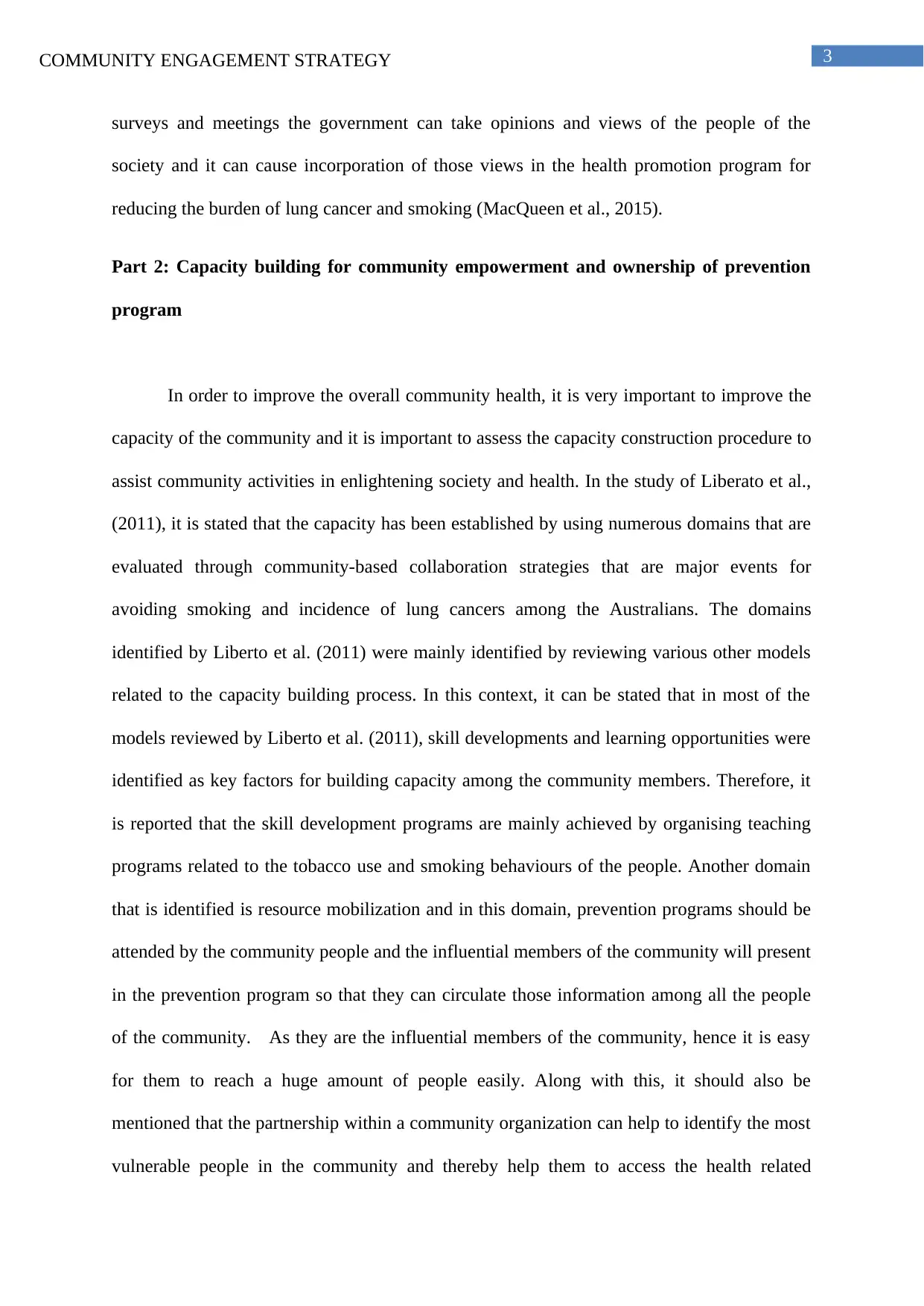
3COMMUNITY ENGAGEMENT STRATEGY
surveys and meetings the government can take opinions and views of the people of the
society and it can cause incorporation of those views in the health promotion program for
reducing the burden of lung cancer and smoking (MacQueen et al., 2015).
Part 2: Capacity building for community empowerment and ownership of prevention
program
In order to improve the overall community health, it is very important to improve the
capacity of the community and it is important to assess the capacity construction procedure to
assist community activities in enlightening society and health. In the study of Liberato et al.,
(2011), it is stated that the capacity has been established by using numerous domains that are
evaluated through community-based collaboration strategies that are major events for
avoiding smoking and incidence of lung cancers among the Australians. The domains
identified by Liberto et al. (2011) were mainly identified by reviewing various other models
related to the capacity building process. In this context, it can be stated that in most of the
models reviewed by Liberto et al. (2011), skill developments and learning opportunities were
identified as key factors for building capacity among the community members. Therefore, it
is reported that the skill development programs are mainly achieved by organising teaching
programs related to the tobacco use and smoking behaviours of the people. Another domain
that is identified is resource mobilization and in this domain, prevention programs should be
attended by the community people and the influential members of the community will present
in the prevention program so that they can circulate those information among all the people
of the community. As they are the influential members of the community, hence it is easy
for them to reach a huge amount of people easily. Along with this, it should also be
mentioned that the partnership within a community organization can help to identify the most
vulnerable people in the community and thereby help them to access the health related
surveys and meetings the government can take opinions and views of the people of the
society and it can cause incorporation of those views in the health promotion program for
reducing the burden of lung cancer and smoking (MacQueen et al., 2015).
Part 2: Capacity building for community empowerment and ownership of prevention
program
In order to improve the overall community health, it is very important to improve the
capacity of the community and it is important to assess the capacity construction procedure to
assist community activities in enlightening society and health. In the study of Liberato et al.,
(2011), it is stated that the capacity has been established by using numerous domains that are
evaluated through community-based collaboration strategies that are major events for
avoiding smoking and incidence of lung cancers among the Australians. The domains
identified by Liberto et al. (2011) were mainly identified by reviewing various other models
related to the capacity building process. In this context, it can be stated that in most of the
models reviewed by Liberto et al. (2011), skill developments and learning opportunities were
identified as key factors for building capacity among the community members. Therefore, it
is reported that the skill development programs are mainly achieved by organising teaching
programs related to the tobacco use and smoking behaviours of the people. Another domain
that is identified is resource mobilization and in this domain, prevention programs should be
attended by the community people and the influential members of the community will present
in the prevention program so that they can circulate those information among all the people
of the community. As they are the influential members of the community, hence it is easy
for them to reach a huge amount of people easily. Along with this, it should also be
mentioned that the partnership within a community organization can help to identify the most
vulnerable people in the community and thereby help them to access the health related
Paraphrase This Document
Need a fresh take? Get an instant paraphrase of this document with our AI Paraphraser
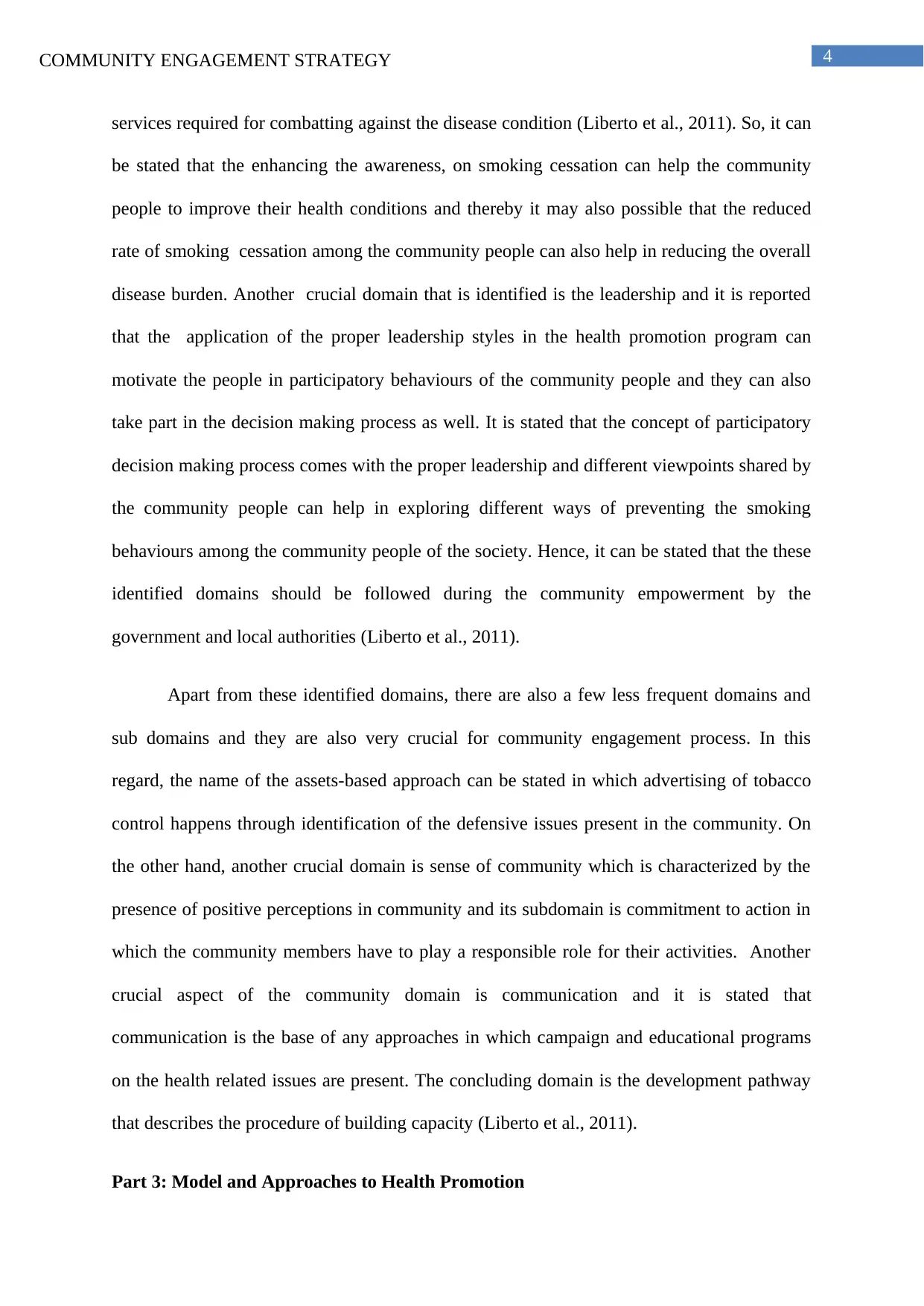
4COMMUNITY ENGAGEMENT STRATEGY
services required for combatting against the disease condition (Liberto et al., 2011). So, it can
be stated that the enhancing the awareness, on smoking cessation can help the community
people to improve their health conditions and thereby it may also possible that the reduced
rate of smoking cessation among the community people can also help in reducing the overall
disease burden. Another crucial domain that is identified is the leadership and it is reported
that the application of the proper leadership styles in the health promotion program can
motivate the people in participatory behaviours of the community people and they can also
take part in the decision making process as well. It is stated that the concept of participatory
decision making process comes with the proper leadership and different viewpoints shared by
the community people can help in exploring different ways of preventing the smoking
behaviours among the community people of the society. Hence, it can be stated that the these
identified domains should be followed during the community empowerment by the
government and local authorities (Liberto et al., 2011).
Apart from these identified domains, there are also a few less frequent domains and
sub domains and they are also very crucial for community engagement process. In this
regard, the name of the assets-based approach can be stated in which advertising of tobacco
control happens through identification of the defensive issues present in the community. On
the other hand, another crucial domain is sense of community which is characterized by the
presence of positive perceptions in community and its subdomain is commitment to action in
which the community members have to play a responsible role for their activities. Another
crucial aspect of the community domain is communication and it is stated that
communication is the base of any approaches in which campaign and educational programs
on the health related issues are present. The concluding domain is the development pathway
that describes the procedure of building capacity (Liberto et al., 2011).
Part 3: Model and Approaches to Health Promotion
services required for combatting against the disease condition (Liberto et al., 2011). So, it can
be stated that the enhancing the awareness, on smoking cessation can help the community
people to improve their health conditions and thereby it may also possible that the reduced
rate of smoking cessation among the community people can also help in reducing the overall
disease burden. Another crucial domain that is identified is the leadership and it is reported
that the application of the proper leadership styles in the health promotion program can
motivate the people in participatory behaviours of the community people and they can also
take part in the decision making process as well. It is stated that the concept of participatory
decision making process comes with the proper leadership and different viewpoints shared by
the community people can help in exploring different ways of preventing the smoking
behaviours among the community people of the society. Hence, it can be stated that the these
identified domains should be followed during the community empowerment by the
government and local authorities (Liberto et al., 2011).
Apart from these identified domains, there are also a few less frequent domains and
sub domains and they are also very crucial for community engagement process. In this
regard, the name of the assets-based approach can be stated in which advertising of tobacco
control happens through identification of the defensive issues present in the community. On
the other hand, another crucial domain is sense of community which is characterized by the
presence of positive perceptions in community and its subdomain is commitment to action in
which the community members have to play a responsible role for their activities. Another
crucial aspect of the community domain is communication and it is stated that
communication is the base of any approaches in which campaign and educational programs
on the health related issues are present. The concluding domain is the development pathway
that describes the procedure of building capacity (Liberto et al., 2011).
Part 3: Model and Approaches to Health Promotion
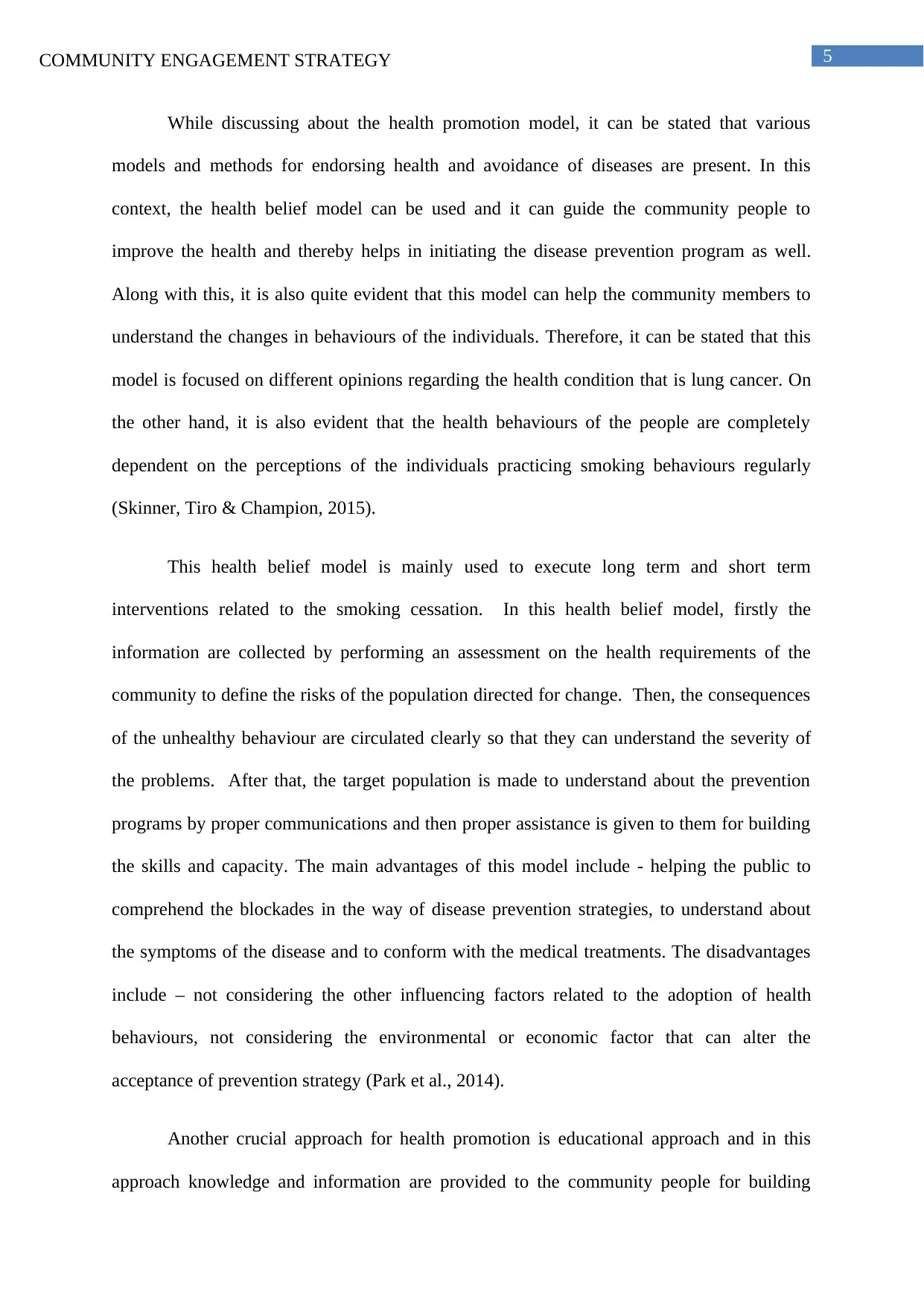
5COMMUNITY ENGAGEMENT STRATEGY
While discussing about the health promotion model, it can be stated that various
models and methods for endorsing health and avoidance of diseases are present. In this
context, the health belief model can be used and it can guide the community people to
improve the health and thereby helps in initiating the disease prevention program as well.
Along with this, it is also quite evident that this model can help the community members to
understand the changes in behaviours of the individuals. Therefore, it can be stated that this
model is focused on different opinions regarding the health condition that is lung cancer. On
the other hand, it is also evident that the health behaviours of the people are completely
dependent on the perceptions of the individuals practicing smoking behaviours regularly
(Skinner, Tiro & Champion, 2015).
This health belief model is mainly used to execute long term and short term
interventions related to the smoking cessation. In this health belief model, firstly the
information are collected by performing an assessment on the health requirements of the
community to define the risks of the population directed for change. Then, the consequences
of the unhealthy behaviour are circulated clearly so that they can understand the severity of
the problems. After that, the target population is made to understand about the prevention
programs by proper communications and then proper assistance is given to them for building
the skills and capacity. The main advantages of this model include - helping the public to
comprehend the blockades in the way of disease prevention strategies, to understand about
the symptoms of the disease and to conform with the medical treatments. The disadvantages
include – not considering the other influencing factors related to the adoption of health
behaviours, not considering the environmental or economic factor that can alter the
acceptance of prevention strategy (Park et al., 2014).
Another crucial approach for health promotion is educational approach and in this
approach knowledge and information are provided to the community people for building
While discussing about the health promotion model, it can be stated that various
models and methods for endorsing health and avoidance of diseases are present. In this
context, the health belief model can be used and it can guide the community people to
improve the health and thereby helps in initiating the disease prevention program as well.
Along with this, it is also quite evident that this model can help the community members to
understand the changes in behaviours of the individuals. Therefore, it can be stated that this
model is focused on different opinions regarding the health condition that is lung cancer. On
the other hand, it is also evident that the health behaviours of the people are completely
dependent on the perceptions of the individuals practicing smoking behaviours regularly
(Skinner, Tiro & Champion, 2015).
This health belief model is mainly used to execute long term and short term
interventions related to the smoking cessation. In this health belief model, firstly the
information are collected by performing an assessment on the health requirements of the
community to define the risks of the population directed for change. Then, the consequences
of the unhealthy behaviour are circulated clearly so that they can understand the severity of
the problems. After that, the target population is made to understand about the prevention
programs by proper communications and then proper assistance is given to them for building
the skills and capacity. The main advantages of this model include - helping the public to
comprehend the blockades in the way of disease prevention strategies, to understand about
the symptoms of the disease and to conform with the medical treatments. The disadvantages
include – not considering the other influencing factors related to the adoption of health
behaviours, not considering the environmental or economic factor that can alter the
acceptance of prevention strategy (Park et al., 2014).
Another crucial approach for health promotion is educational approach and in this
approach knowledge and information are provided to the community people for building
⊘ This is a preview!⊘
Do you want full access?
Subscribe today to unlock all pages.

Trusted by 1+ million students worldwide
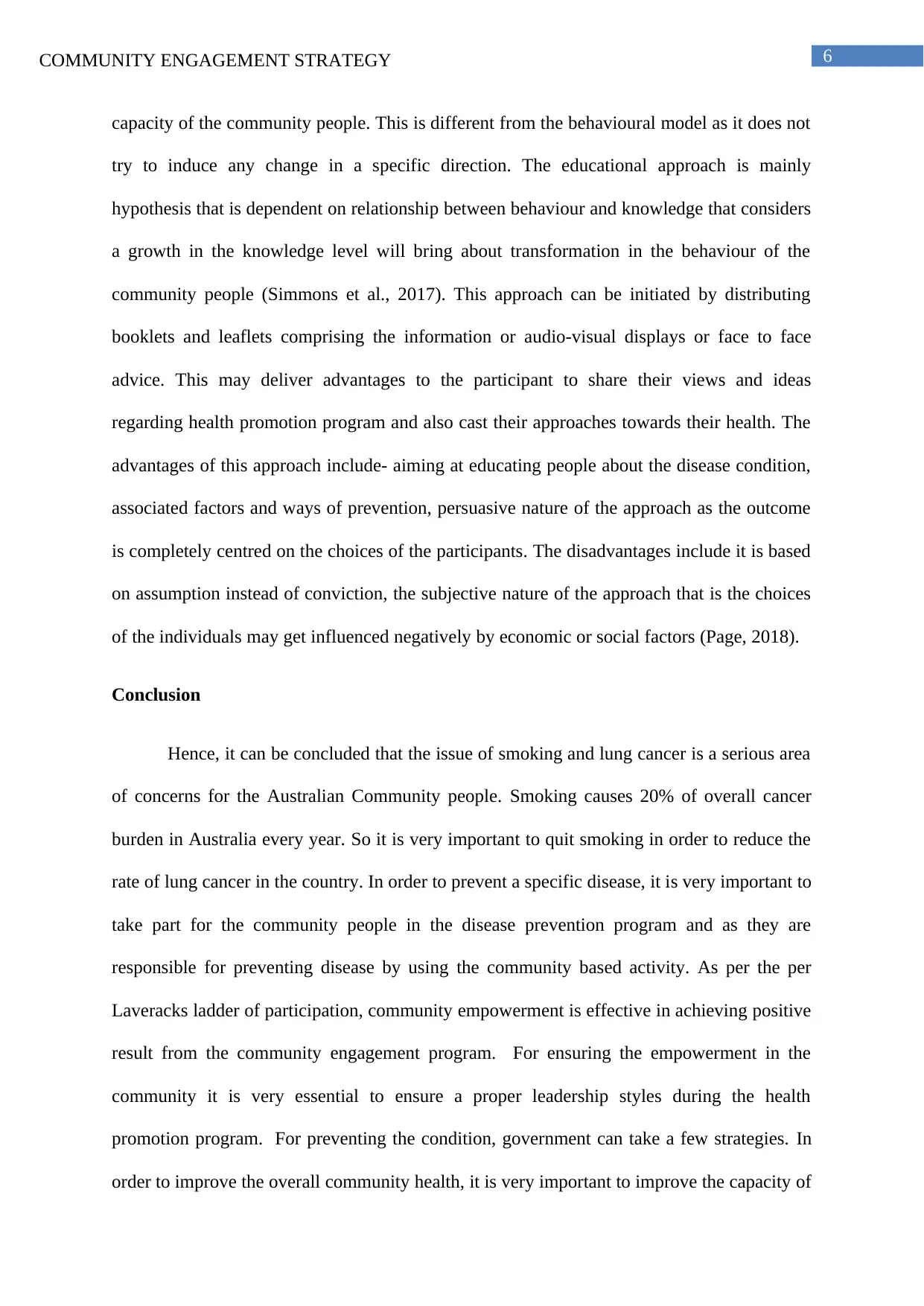
6COMMUNITY ENGAGEMENT STRATEGY
capacity of the community people. This is different from the behavioural model as it does not
try to induce any change in a specific direction. The educational approach is mainly
hypothesis that is dependent on relationship between behaviour and knowledge that considers
a growth in the knowledge level will bring about transformation in the behaviour of the
community people (Simmons et al., 2017). This approach can be initiated by distributing
booklets and leaflets comprising the information or audio-visual displays or face to face
advice. This may deliver advantages to the participant to share their views and ideas
regarding health promotion program and also cast their approaches towards their health. The
advantages of this approach include- aiming at educating people about the disease condition,
associated factors and ways of prevention, persuasive nature of the approach as the outcome
is completely centred on the choices of the participants. The disadvantages include it is based
on assumption instead of conviction, the subjective nature of the approach that is the choices
of the individuals may get influenced negatively by economic or social factors (Page, 2018).
Conclusion
Hence, it can be concluded that the issue of smoking and lung cancer is a serious area
of concerns for the Australian Community people. Smoking causes 20% of overall cancer
burden in Australia every year. So it is very important to quit smoking in order to reduce the
rate of lung cancer in the country. In order to prevent a specific disease, it is very important to
take part for the community people in the disease prevention program and as they are
responsible for preventing disease by using the community based activity. As per the per
Laveracks ladder of participation, community empowerment is effective in achieving positive
result from the community engagement program. For ensuring the empowerment in the
community it is very essential to ensure a proper leadership styles during the health
promotion program. For preventing the condition, government can take a few strategies. In
order to improve the overall community health, it is very important to improve the capacity of
capacity of the community people. This is different from the behavioural model as it does not
try to induce any change in a specific direction. The educational approach is mainly
hypothesis that is dependent on relationship between behaviour and knowledge that considers
a growth in the knowledge level will bring about transformation in the behaviour of the
community people (Simmons et al., 2017). This approach can be initiated by distributing
booklets and leaflets comprising the information or audio-visual displays or face to face
advice. This may deliver advantages to the participant to share their views and ideas
regarding health promotion program and also cast their approaches towards their health. The
advantages of this approach include- aiming at educating people about the disease condition,
associated factors and ways of prevention, persuasive nature of the approach as the outcome
is completely centred on the choices of the participants. The disadvantages include it is based
on assumption instead of conviction, the subjective nature of the approach that is the choices
of the individuals may get influenced negatively by economic or social factors (Page, 2018).
Conclusion
Hence, it can be concluded that the issue of smoking and lung cancer is a serious area
of concerns for the Australian Community people. Smoking causes 20% of overall cancer
burden in Australia every year. So it is very important to quit smoking in order to reduce the
rate of lung cancer in the country. In order to prevent a specific disease, it is very important to
take part for the community people in the disease prevention program and as they are
responsible for preventing disease by using the community based activity. As per the per
Laveracks ladder of participation, community empowerment is effective in achieving positive
result from the community engagement program. For ensuring the empowerment in the
community it is very essential to ensure a proper leadership styles during the health
promotion program. For preventing the condition, government can take a few strategies. In
order to improve the overall community health, it is very important to improve the capacity of
Paraphrase This Document
Need a fresh take? Get an instant paraphrase of this document with our AI Paraphraser
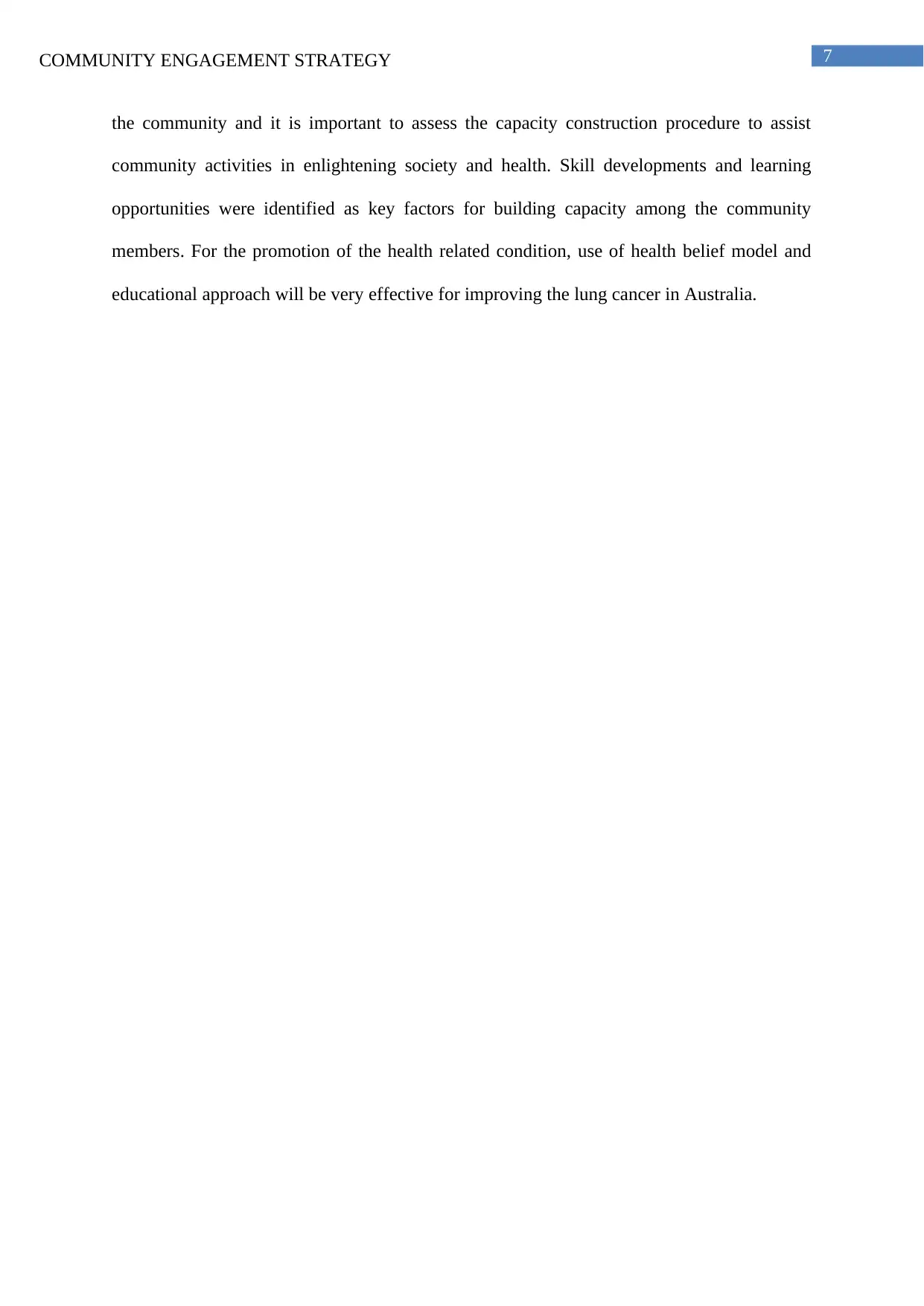
7COMMUNITY ENGAGEMENT STRATEGY
the community and it is important to assess the capacity construction procedure to assist
community activities in enlightening society and health. Skill developments and learning
opportunities were identified as key factors for building capacity among the community
members. For the promotion of the health related condition, use of health belief model and
educational approach will be very effective for improving the lung cancer in Australia.
the community and it is important to assess the capacity construction procedure to assist
community activities in enlightening society and health. Skill developments and learning
opportunities were identified as key factors for building capacity among the community
members. For the promotion of the health related condition, use of health belief model and
educational approach will be very effective for improving the lung cancer in Australia.
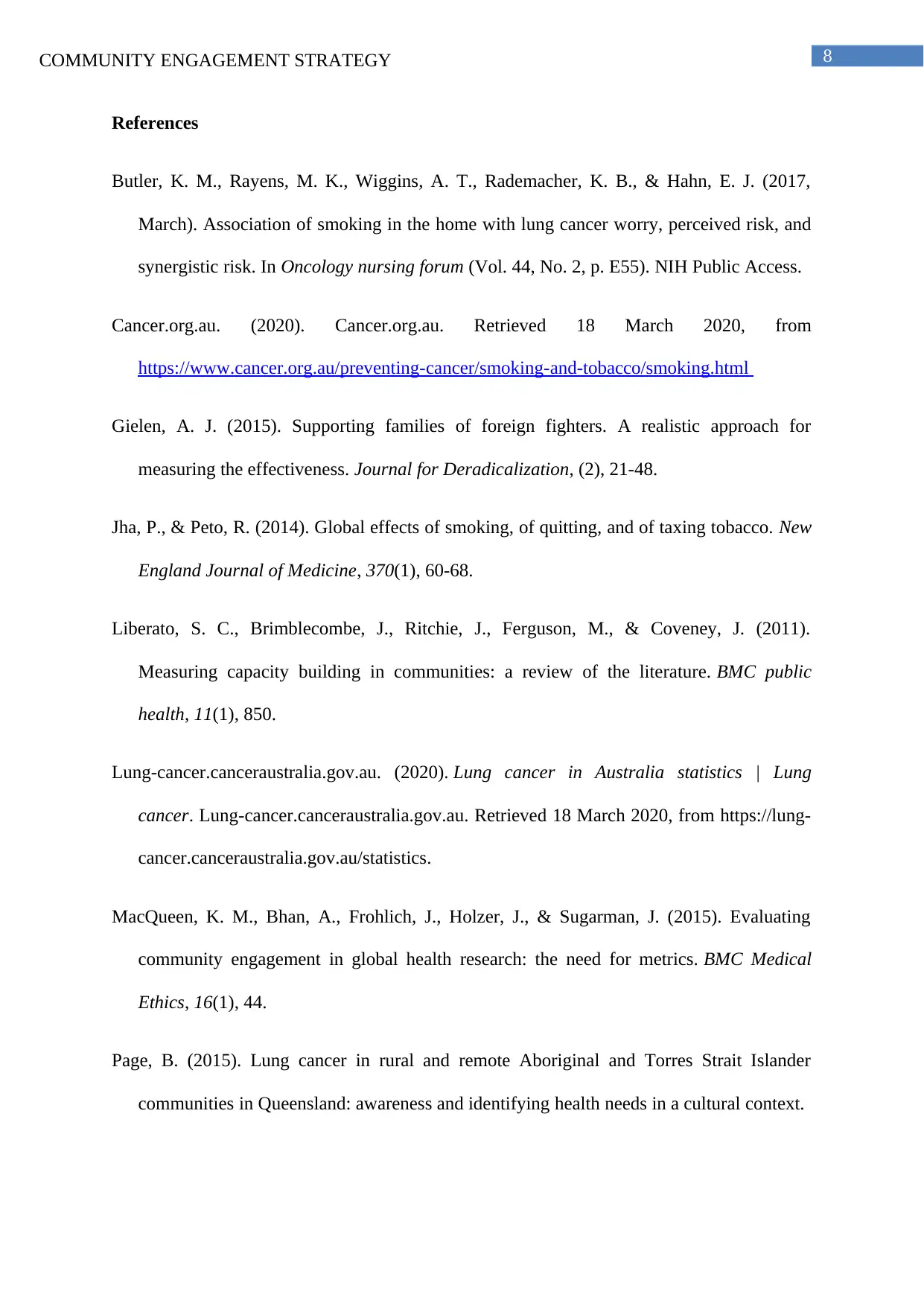
8COMMUNITY ENGAGEMENT STRATEGY
References
Butler, K. M., Rayens, M. K., Wiggins, A. T., Rademacher, K. B., & Hahn, E. J. (2017,
March). Association of smoking in the home with lung cancer worry, perceived risk, and
synergistic risk. In Oncology nursing forum (Vol. 44, No. 2, p. E55). NIH Public Access.
Cancer.org.au. (2020). Cancer.org.au. Retrieved 18 March 2020, from
https://www.cancer.org.au/preventing-cancer/smoking-and-tobacco/smoking.html
Gielen, A. J. (2015). Supporting families of foreign fighters. A realistic approach for
measuring the effectiveness. Journal for Deradicalization, (2), 21-48.
Jha, P., & Peto, R. (2014). Global effects of smoking, of quitting, and of taxing tobacco. New
England Journal of Medicine, 370(1), 60-68.
Liberato, S. C., Brimblecombe, J., Ritchie, J., Ferguson, M., & Coveney, J. (2011).
Measuring capacity building in communities: a review of the literature. BMC public
health, 11(1), 850.
Lung-cancer.canceraustralia.gov.au. (2020). Lung cancer in Australia statistics | Lung
cancer. Lung-cancer.canceraustralia.gov.au. Retrieved 18 March 2020, from https://lung-
cancer.canceraustralia.gov.au/statistics.
MacQueen, K. M., Bhan, A., Frohlich, J., Holzer, J., & Sugarman, J. (2015). Evaluating
community engagement in global health research: the need for metrics. BMC Medical
Ethics, 16(1), 44.
Page, B. (2015). Lung cancer in rural and remote Aboriginal and Torres Strait Islander
communities in Queensland: awareness and identifying health needs in a cultural context.
References
Butler, K. M., Rayens, M. K., Wiggins, A. T., Rademacher, K. B., & Hahn, E. J. (2017,
March). Association of smoking in the home with lung cancer worry, perceived risk, and
synergistic risk. In Oncology nursing forum (Vol. 44, No. 2, p. E55). NIH Public Access.
Cancer.org.au. (2020). Cancer.org.au. Retrieved 18 March 2020, from
https://www.cancer.org.au/preventing-cancer/smoking-and-tobacco/smoking.html
Gielen, A. J. (2015). Supporting families of foreign fighters. A realistic approach for
measuring the effectiveness. Journal for Deradicalization, (2), 21-48.
Jha, P., & Peto, R. (2014). Global effects of smoking, of quitting, and of taxing tobacco. New
England Journal of Medicine, 370(1), 60-68.
Liberato, S. C., Brimblecombe, J., Ritchie, J., Ferguson, M., & Coveney, J. (2011).
Measuring capacity building in communities: a review of the literature. BMC public
health, 11(1), 850.
Lung-cancer.canceraustralia.gov.au. (2020). Lung cancer in Australia statistics | Lung
cancer. Lung-cancer.canceraustralia.gov.au. Retrieved 18 March 2020, from https://lung-
cancer.canceraustralia.gov.au/statistics.
MacQueen, K. M., Bhan, A., Frohlich, J., Holzer, J., & Sugarman, J. (2015). Evaluating
community engagement in global health research: the need for metrics. BMC Medical
Ethics, 16(1), 44.
Page, B. (2015). Lung cancer in rural and remote Aboriginal and Torres Strait Islander
communities in Queensland: awareness and identifying health needs in a cultural context.
⊘ This is a preview!⊘
Do you want full access?
Subscribe today to unlock all pages.

Trusted by 1+ million students worldwide
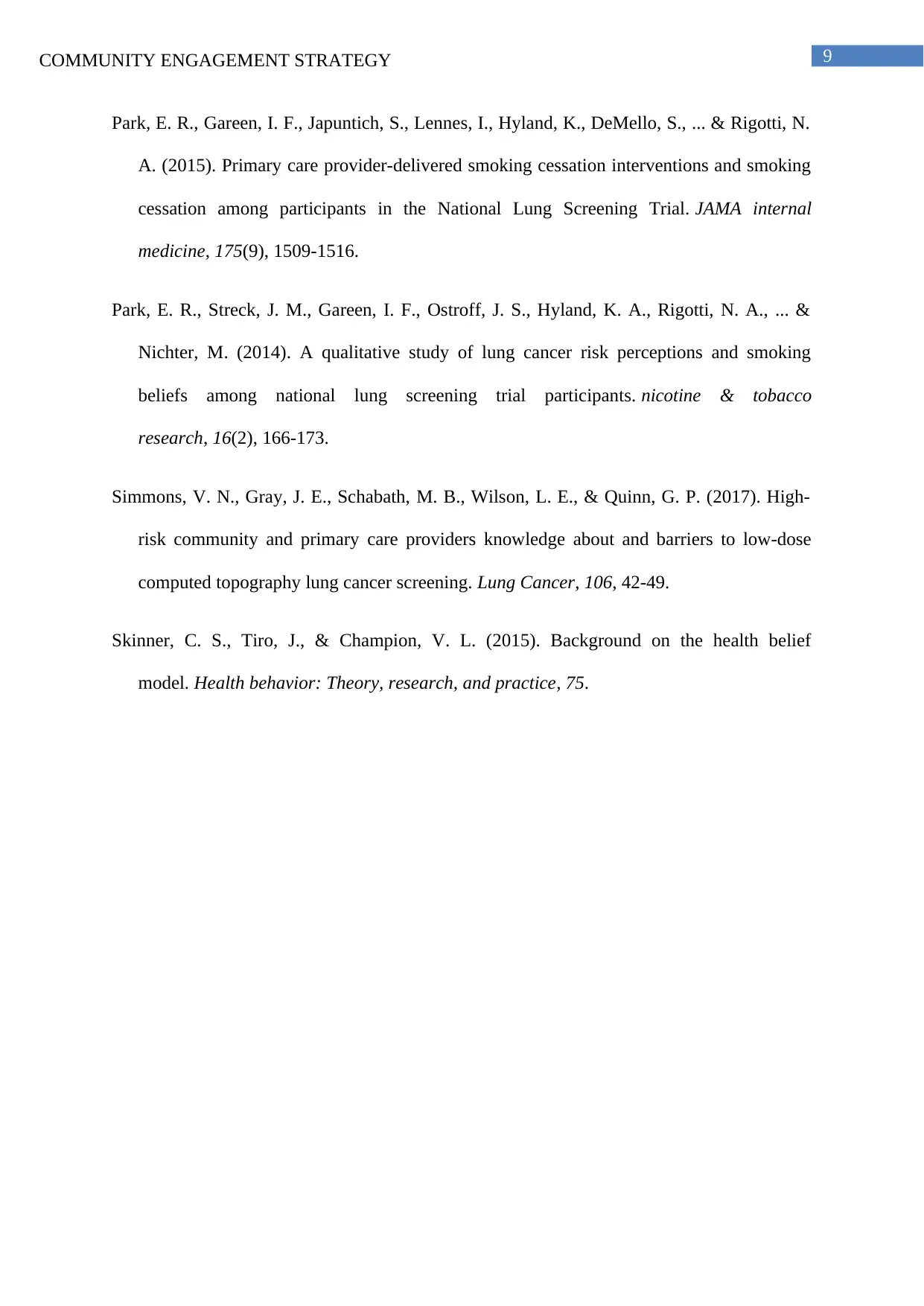
9COMMUNITY ENGAGEMENT STRATEGY
Park, E. R., Gareen, I. F., Japuntich, S., Lennes, I., Hyland, K., DeMello, S., ... & Rigotti, N.
A. (2015). Primary care provider-delivered smoking cessation interventions and smoking
cessation among participants in the National Lung Screening Trial. JAMA internal
medicine, 175(9), 1509-1516.
Park, E. R., Streck, J. M., Gareen, I. F., Ostroff, J. S., Hyland, K. A., Rigotti, N. A., ... &
Nichter, M. (2014). A qualitative study of lung cancer risk perceptions and smoking
beliefs among national lung screening trial participants. nicotine & tobacco
research, 16(2), 166-173.
Simmons, V. N., Gray, J. E., Schabath, M. B., Wilson, L. E., & Quinn, G. P. (2017). High-
risk community and primary care providers knowledge about and barriers to low-dose
computed topography lung cancer screening. Lung Cancer, 106, 42-49.
Skinner, C. S., Tiro, J., & Champion, V. L. (2015). Background on the health belief
model. Health behavior: Theory, research, and practice, 75.
Park, E. R., Gareen, I. F., Japuntich, S., Lennes, I., Hyland, K., DeMello, S., ... & Rigotti, N.
A. (2015). Primary care provider-delivered smoking cessation interventions and smoking
cessation among participants in the National Lung Screening Trial. JAMA internal
medicine, 175(9), 1509-1516.
Park, E. R., Streck, J. M., Gareen, I. F., Ostroff, J. S., Hyland, K. A., Rigotti, N. A., ... &
Nichter, M. (2014). A qualitative study of lung cancer risk perceptions and smoking
beliefs among national lung screening trial participants. nicotine & tobacco
research, 16(2), 166-173.
Simmons, V. N., Gray, J. E., Schabath, M. B., Wilson, L. E., & Quinn, G. P. (2017). High-
risk community and primary care providers knowledge about and barriers to low-dose
computed topography lung cancer screening. Lung Cancer, 106, 42-49.
Skinner, C. S., Tiro, J., & Champion, V. L. (2015). Background on the health belief
model. Health behavior: Theory, research, and practice, 75.
Paraphrase This Document
Need a fresh take? Get an instant paraphrase of this document with our AI Paraphraser
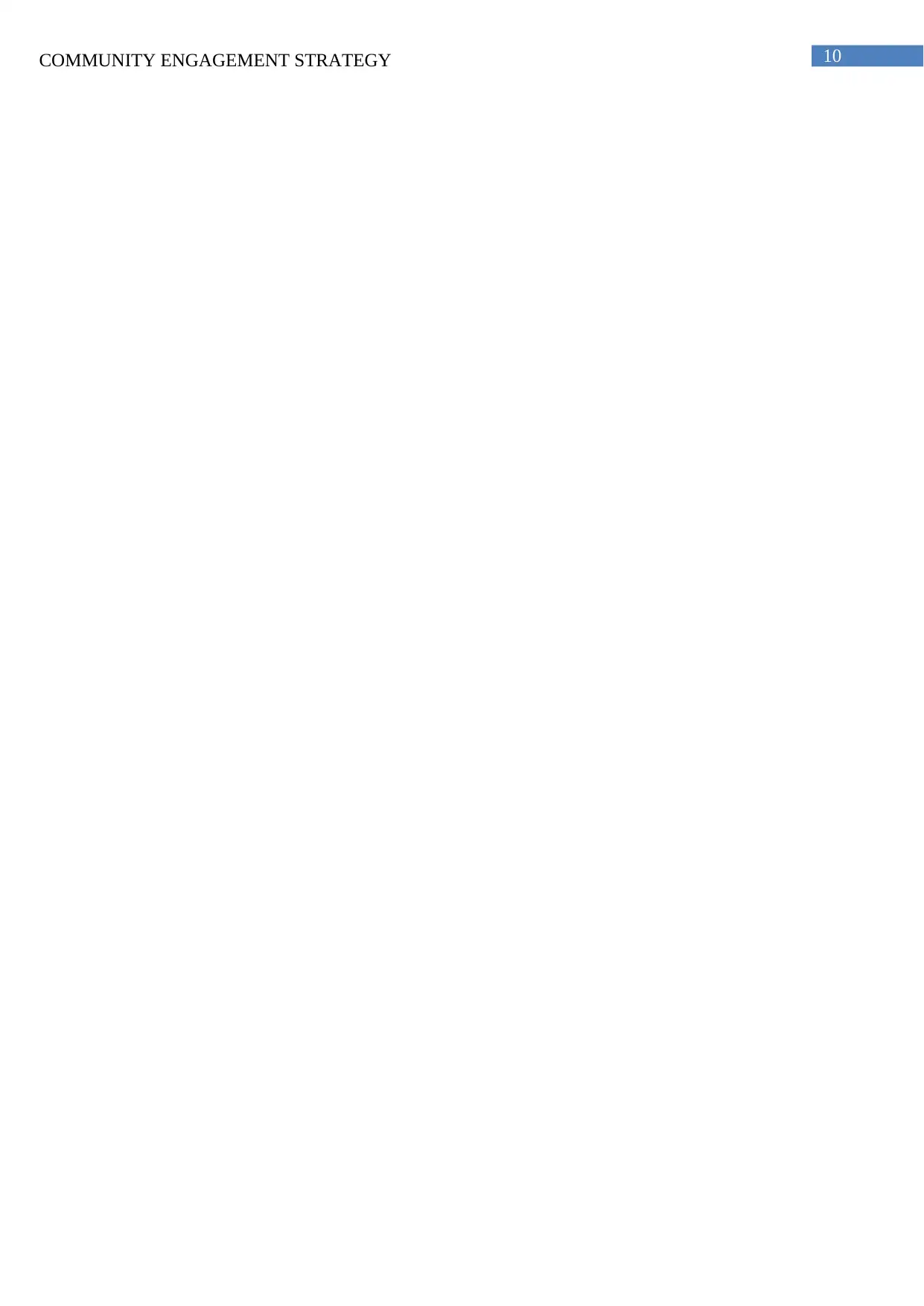
10COMMUNITY ENGAGEMENT STRATEGY
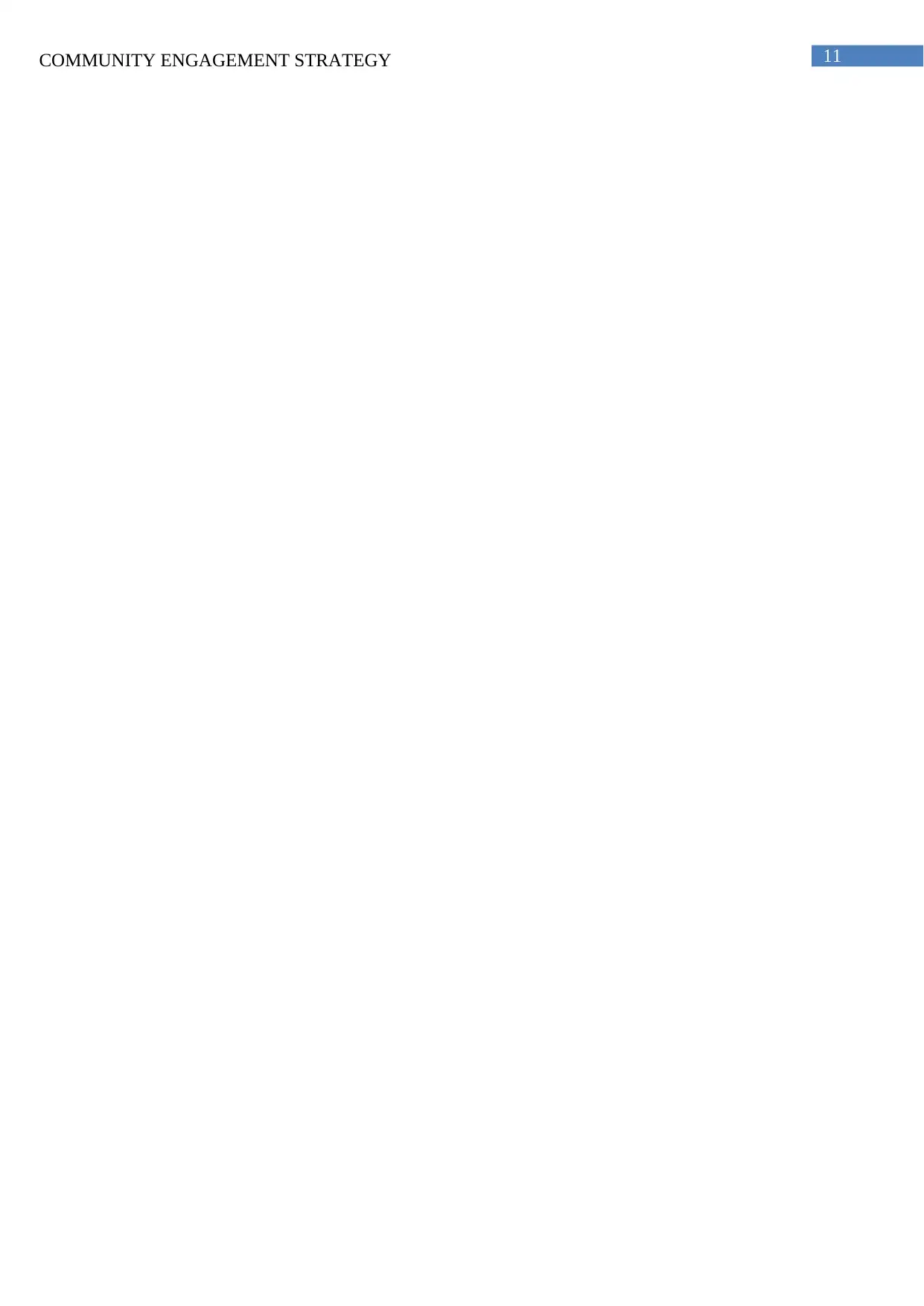
11COMMUNITY ENGAGEMENT STRATEGY
⊘ This is a preview!⊘
Do you want full access?
Subscribe today to unlock all pages.

Trusted by 1+ million students worldwide
1 out of 12
Related Documents
Your All-in-One AI-Powered Toolkit for Academic Success.
+13062052269
info@desklib.com
Available 24*7 on WhatsApp / Email
![[object Object]](/_next/static/media/star-bottom.7253800d.svg)
Unlock your academic potential
Copyright © 2020–2025 A2Z Services. All Rights Reserved. Developed and managed by ZUCOL.




